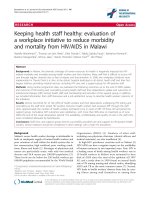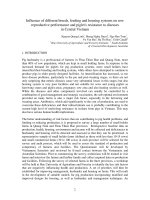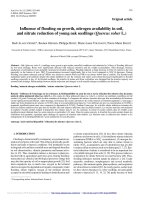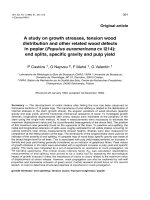Effect of different housing systems on growth performance, feed consumption, morbidity and mortality of broiler rabbits
Bạn đang xem bản rút gọn của tài liệu. Xem và tải ngay bản đầy đủ của tài liệu tại đây (166.62 KB, 7 trang )
Int.J.Curr.Microbiol.App.Sci (2019) 8(3): 2115-2121
International Journal of Current Microbiology and Applied Sciences
ISSN: 2319-7706 Volume 8 Number 03 (2019)
Journal homepage:
Original Research Article
/>
Effect of Different Housing Systems on Growth Performance, Feed
Consumption, Morbidity and Mortality of Broiler Rabbits
R.K. Prajapati1, H.D. Chauhan2, M.M. Pawar1, J.P. Gupta3, A.K. Srivastava1,
A.B. Paregi1, P.D. Patel1, J.V. Patel1* and N.K. Thakkar1
1
Department of Livestock Production and Management, 2Department of Animal Nutrition,
Department of Animal Genetics and Breeding, College of Veterinary Science and Animal
Husbandry, Sardarkrushinagar Dantiwada Agricultural University, Sardarkrushinagar, India
3
*Corresponding author
ABSTRACT
Keywords
Rabbit, Housing,
Growth, Feed
Intake, Mortality
Article Info
Accepted:
18 February 2019
Available Online:
10 March 2019
The present investigation was conducted to study the effects of different housing systems
on growth performance, feed consumption, morbidity and mortality of broiler rabbits in
semi arid region of North Gujarat. Total 24 weaned rabbits (28 days age) were randomly
divided in two housing treatments, T 1 (Cage housing) and T2 (Deep litter housing system).
The duration of experiment was 8 weeks. Dimensions of cage were 3×2×2 feet (3
rabbits/cage) whereas, in deep litter, 12 rabbits were kept in 24 square feet area (2 square
feet/rabbit). Animals were fed restricted amount of concentrate and vegetables whereas
green fodder was fed ad-lib. Weighted quantity of feed were given to rabbits and left over
was collected next day early morning before offering fresh feed. Weekly observations
were recorded for weekly body weight, weight gain and daily feed consumption data
generated were analyzed for significant differences. Initial average body weight was
0.739±0.05Kg and 0.736±0.07Kg, respectively, in T1 and T2 groups. At the end of
experimental period (12th week of age), there was no significant difference in the final
body weight (2.619±0.09 kg v/s 2.500±0.10 kg) between T1 and T2 groups. Average
weekly body weight gain was marginally high (but non-significant) in T1 (0.234±0.02 kg)
than T2 (0.220±0.01 kg). There was no apparent morbidity and mortality in rabbits during
the experimental period. The results indicate that weight gain were at par in the cage and
deep litter system of housing. Further, maintaining well hygienic condition in deep litter
system and changing the litter materials at the regular interval; gives the similar results as
in cage system.
Introduction
Rabbit belong to the order lagomorpha, which
has two families (leporidae and ochotonidae)
that comprise 12 genera. The modern rabbit is
Oryctolagus cuniculus, a descendant of the
european wild rabbit. The rapid growth of
human population and improvement in per
capita consumption continue to widen the gap
between the demand and supply of meat. This
2115
Int.J.Curr.Microbiol.App.Sci (2019) 8(3): 2115-2121
gap can be bridged only by increasing meat
production from different livestock species
through improving their genetic makeup
together with improved managerial practices.
The rabbit population is 0.59 million in India,
and is considered as livestock for the first time
during 2003 in a livestock censes but
domestication of rabbits since last 1972
(Anonymous, 2016). There are two
conventional housing methods in rabbit
rearing, rabbits are either kept in cages
without (or with) bedding or group housed and
Wire cage housing for rabbits is considered
most economical and is more widespread
(Morton et al., 1993), although each housing
method has its advantages and disadvantages.
When cage keeping without bedding is
applied, rabbit excrements falls through the
bars without heaping, so the risk of coccidiosis
is reduced.
When kept on straw bedding, rabbits have a
warmer lying area, there is a lower influence
of outside temperatures, yet constant contact
with the manure increases the risk of
coccidiosis. In recent years, consumer’s
interest in specially products derived from
free-range or organic production system has
steadily increased in Europe and other parts of
the world. Generally, extensive housing
systems provide animals with more space and
freedom of movement to animals, which
permit a broad range of behavior patterns and
better satisfy the natural and social needs of
rabbits (Morisse et al., 1999). One of the
solutions to the problem is changing of the
cage design by making all or part of the cages
higher. Housing systems should be efficient in
environmental thermoregulation to insure
better rearing through good biological
performance, thus high economic return.
Housing for livestock is designed to suit the
prevailing climatic conditions, bearing in mind
the availability and cost of materials and local
construction workers skills when thermal
stress would negatively influence animal
welfare and productivity.
Materials and Methods
The study was conducted at Rabbit Unit,
Instructional Livestock Farm Complex,
Department of Livestock Production and
Management, College of Veterinary Science
and Animal Husbandry, Sardarkrushinagar
Dantiwada
Agricultural
University,
Sardarkrushinagar. All the experimental
rabbits were reared with does till 4th week of
age and after that weaning were done and they
were distributed randomly into 2 treatment
groups as per the technical plan of
investigation. The treatment groups were
made by keeping rabbits in cage and deep
litter. In one cage of 3 × 2 × 2 feet, maximum
3 experimental rabbits were kept. Door of the
cage was rear side of cage and cage was kept 2
feet high on the metal stand from the floor. In
Deep litter house the wall was prepared by red
bricks and height was 2.5 feet: deep litter
material of wheat straw was spread of 5 cm
thickness. Floor of deep litter housing was
made using Kota stone. In deep litter system 2
square feet floor space (minimum) was
provided to each rabbit. All the rabbits were
weighed individually with electronic weighing
balance in morning before offering feed and
water and that was taken as initial body weight
of rabbits.
All possible measures were strictly followed
to
maintain
standard
and
uniform
managemental conditions to all the
experimental
rabbits
throughout
the
experimental period. Room temperature was
almost in the range of 18-25oC throughout the
experimental period. Experimental rabbits
were offered, measured amount of concentrate
and fresh vegetables, while green fodder and
clean and fresh drinking water was provided
adlibitum to all experimental rabbits. The
water bowls were being washed daily and then
filled with cool fresh water frequently as to
avoid the heat stress. The rabbits were
protected against various diseases by taking
2116
Int.J.Curr.Microbiol.App.Sci (2019) 8(3): 2115-2121
strict sanitary measures and routine cleaning
and washing of feeding and watering utensils.
Faecal samples were examined at monthly
interval (at 8th and 12th week of age) for
parasitic infection (coccidial oocyst) in the
department of veterinary parasitology using
sedimentation method for diagnosis of
parasitic eggs. The data were analyzed using
standard statistical procedures for mean
comparison of differences between treatment
groups by T-test as described by Snedecor and
Cochran (1994).
Results and Discussion
The growth performance indices of the
weaned rabbits raised under the two different
housing systems are presented in Table 1 and
2 and feed consumption were showed in Table
3. During the 11th and 12thweek of age
fighting between animal was accrued and
animal was injured so that two rabbits of cage
housing system were excluded from
experiment for two weeks. Data of two
animals was not included in last two weeks.
The result showed that no significant (P<
0.05) different in the weekly body weight,
body weight gain and feed consumption.
bedded floor showed the lowest final weight
as compared to plastic slat or wire net floors
but housing was not significantly affected.
Stewart and Suckow (2016) observed no
significant differences in body weight between
groups housed in cages with different heights
and amounts of floor space.
Laxmi et al., (2009) found fryers reared in
backyard weighed heavier than those kept in
cages, although the difference was statistically
not significant and Zoltan et al., (2008)
reported that housing system had no
significant effect on body weight. Overall
result was non significant on the body weight
due to different housing system because of the
uniformity in feeding and watering as well as
environmental conditions.
The findings was in contrast with the earlier
reporters; Shivkumar et al., (1991), Lazzaroni
et al., (2009), Pinheiro et al., (2011), Xiccato
et al., (2013a), Matics et al., (2014), Maha et
al., (2015), Chandra et al., (2014), Nevalainen
et al., (2007), Robert and codrin. (2009),
Shehu and Mahmoud.(2013), Maertens and
Van. (2000) they found significant effect of
housing on body weight.
Weekly body weight (Kg)
Body weight gain (Kg)
The mean of twelfth week body weight (Final
body weight) was found to be 2.619±0.09 and
2.500±0.10 kg in cage housing system and
deep litter housing system respectively.
Overall, result showed the body weight of
rabbits during 12th week of age was at par in
both the housing systems. Body weight in
cage housing system (2.619±0.09 kg, T1) and
(2.500±0.10 kg, T2) had no significant
difference. The findings was in agreement
with the findings of Verga et al., (2004) they
found no significant difference in live weight
from simple cage and wood stick hanging
from the ceiling of the cage. Trocino et al.,
(2008) notice that the rabbits kept on straw
The mean weekly body weight gains (Kg)
along with standard errors for all the weeks
are presented in Table 2. At the end of 4th
week (weaning) body weight of 24 rabbits
were taken and average of it was recorded to
be 0.740 ± 0.062 kg. The mean for body
weight gain during whole experimental period
(BWG5-12) was found to be the highest in cage
housing system (0.234 ± 0.024 kg) followed
by deep litter housing system (0.220 ± 0.017
kg). The results revealed that body weight
gain of rabbits during 12th week of age was
higher in cage system as compare to deep litter
housing system. Mean Body weight gain in
cage housing system (0.234 ± 0.024 kg) and
2117
Int.J.Curr.Microbiol.App.Sci (2019) 8(3): 2115-2121
deep litter housing system (0.220 ± 0.017 kg)
had no significant difference. The findings
were in agreement with the reports of earlier
workers. Stewart and Suckow (2016) observed
no significant differences in body weight gain
between groups housed in cages with different
heights and amounts of floor space. Laxmi et
al., (2009) found that at the age of 4, 8, and 10
weeks, the fryers reared in backyard weight
gain higher than those kept in cages, although
the difference was statistically not significant,
Zoltan et al., (2008) reported that the average
daily weight gain at the age of 5th and 11th
weeks was not differ due to cage height.
Overall they reported that body weight gain
was not affected by different housing systems.
The findings were in contrast with the reports
of earlier workers Shivkumar et al., (1991),
Bosco et al., (2002), Verga et al., (2004),
Trocino et al., (2008), Villalobos et al.,
(2008), Lazzaroni et al., (2009), Pinheiro et
al., (2011), Xiccato et al., (2013a), Matics et
al., (2014), Maha et al., (2015), Chandra et al.,
(2014), Nevalainen et al., (2007), Robert and
codrin (2009), Shehu and Mahmoud.(2013),
Maertens and Van. (2000), Princz et al.,
(2008), Metzger et al (2003) who reported that
the housing systems had significant (p < 0.05)
effect on the body weight gain. In the study no
morbidity and mortality was observed in any
group. During the 11th and 12thweek of age
fighting between animal was accrued and
animal was injured so that two rabbits of cage
housing system were excluded from
experiment for two weeks. These finding are
in agreement with earliest studies of Zoltan et
al., (2008), reported that housing systems has
no effect on morbidity during the 8 week
duration but increases at age 11 and 12 week
in rabbits. Similarly, Paci et al., (2008)
reported that only T16 (16 animal/cage) group
have higher aggressiveness compared to T8 (8
animal/cage) group.
Overall, the results revealed that feed
consumption (g/rabbit/week) for all the weeks
was remain higher in cage housing group (T1)
compared to deep litter housing group deep
litter housing system. The average feed
consumption
(g/rabbit/week)
during
experimental period (5- 12th week) was 807.9
± 64.99 and 809.1 ± 65.40 g in cage housing
system and deep litter housing system
respectively. Statistical analysis showed that
there was no significant difference in feed
intake due to different housing systems.
Table.1 Average weekly body weight (kg) of broiler rabbits at different age
Age in weeks
4
5
6
7
8
9
10
11
12
Overall
Cage housing system
(n=12)
0.739±0.054
0.997±0.059
1.283±0.063
1.520±0.064
1.826±0.077
2.072±0.075
2.275±0.085
2.389±0.065
2.536±0.093
2.344 ± 0.189 NS
Deep litter housing system
(n=12)
0.736±0.075
0.977±0.081
1.250±0.082
1.494±0.079
1.754±0.087
1.976±0.082
2.197±0.091
2.360±0.101
2.500±0.106
2.429 ±0.182 NS
All the average weekly body weights, under different housing systems do not differ significantly (p≤0.05).
2118
Int.J.Curr.Microbiol.App.Sci (2019) 8(3): 2115-2121
Table.2 Average weekly body weight gain of broiler rabbits at different age
Age in weeks
4-5
5-6
6-7
7-8
8-9
9-10
10-11
11-12
Overall
Cage housing system
(n=12)
0.258 ± 0.010
0.286±0.012
0.236±0.013
0.305±0.025
0.246±0.011
0.202±0.013
0.114±0.021
0.146±0.024
0.225 ± 0.024 NS
Deep litter housing system
(n=12)
0.241±0.012
0.273±0.009
0.244±0.021
0.259±0.021
0.221±0.013
0.220±0.014
0.163±0.012
0.139±0.017
0.220 ± 0.017 NS
All the average weekly body weight gains, under different housing systems did not differ significantly (p≤0.05).
Table.3 Average DM consumption (g/rabbit/week) of broiler rabbit at different age
Age in weeks
4-5
5-6
6-7
7-8
8-9
9-10
10-11
11-12
Overall
Cage housing system
(T1)
457.34
683.41
799.01
863.96
923.24
938.35
975.27
979.83
834.4 ± 64.99 NS
Deep litter housing system
(T2)
444.99
643.17
768.13
833.56
907.11
942.40
970.91
962.52
809.1 ± 65.40 NS
DM consumption, under different housing systems did not differ significantly.
The result of present study is supported by the
findings of Zoltan et al., (2008) found that the
cage height did not affect significantly on the
weekly or the total feed consumption. Baiomy
(2012) report that cage density did not affect
feed efficiency. Supporters of present findings
reported housing systems had no effect on
feed consumption.
However, in contrast to the present findings
Whary, et al., (1993), Maertens and van
(2000), Lambertini et al., (2001), Bosco et al.,
(2002), Trocino et al., (2008), Owen et al.,
(2008), Lazzaroni et al., (2009), Pinheiro et
al., (2011), Robert and codrin (2009), Shehu
and Mahmoud (2013), Xiccato et al., (2013b),
Matics et al., (2014), reported significant
difference (p<0.05) in DMI due to different
housing systems.
The feed consumption was found at par in
both the housing systems at age of the 12th
weeks might be due to the provision of
ad.libitum feeding in both the groups.
In conclusion,
Specially in term of growth performance both
the housing systems was acceptable but
outdoor (deep litter) rearing system may be
2119
Int.J.Curr.Microbiol.App.Sci (2019) 8(3): 2115-2121
considered favorable alternative housing
system because it satisfy the specific
requirement of rabbits and also allay the
ethical concern of modern consumers: the
better sanitary conditions, greater space
available and both quality and variability of
environment stimuli improved animal
welfare. In cage housing fighting between
animal was observed but no mortality and
morbidity was observed in any group.
The overall feed consumption was higher in
cage housing system.
In cage housing, fighting between animals
was observed but no mortality and morbidity
was observed in any group.
References
Anonymous 2016. Basic Animal Husbandry
Statistics.
Department
of Animal
Husbandry, Dairying and Fisheries.
Ministry of Agriculture, Government of
India. Krishi Bhavan, New Delhi.
Bosco. A. D., Castellini C. and Mugna, C. 2002.
Rearing rabbits on a wire net floor or
straw litter: behaviour, growth and meat
qualitative traits. Livestock Production
Science.75: 149-156.
Baiomy. A. A. 2012. Growth and carcass traits
of New Zealand white rabbits reared in
Upper Egypt as affected by cage
density. Egyptian Poultry Science. 32(3):
475-481.
Chandra S., Mahender M., Prakash, M. G.,
Raghunandan, T. and Reddy K. K. 2014.
Productive performance of broiler rabbits
fed diets supplemented with probiotic and
enzymes under two systems of housing.
Indian Journal of Animal Research. 48(4):
355-361.
Laxmi P. J. Gupta, B. R., Gnana, P. M.,
Ekambaram B. and Amareswari P. 2009.
A study on the performance of fryer
rabbits under different systems of rearing.
Livestock
Research
for
Rural
Development. 21(8).140-145.
Lazzaroni C., Biagini, D. and Lussiana C. 2009.
Different rearing systems for fattening
rabbits:
performance
and
carcass
characteristics. Meat Science. 82: 200204.
Lambertini, L., Vignola, G. and Zaghini, g.
2001. Alternative pen housing system for
fattening rabbits: effect of group density
and litter. World Rabbit Science. 9 (4):
141-147.
Maertens L. and Van H. A. 2000. Performances
of weaned rabbits raised in pens or in
classical cages: first results. In
Proceedings of the 7th world rabbit
congress. 4-7 July 2000 – Valencia Spain.
pp: 335- 440.
Maha S., Wael. A. M., Radi. A. M., Mohamed.
M. E., Sami A. and Midany. E. l.
2015.Effect of weaning age and housing
model on feed intake, growth performance,
hemato-biochemical
parameters
and
economic efficiency of post weaning New
Zealand White rabbits. Alexandria
Journal of Veterinary Sciences. 46: 48-56.
Matics. Z., Szendro. Z., Odermatt. M.,
Gerencsér. Z., Nagy, I., Radnai. I. and
Dalle Z. 2014. Effect of housing
conditions on production, carcass and
meat quality traits of growing rabbits.
Meat Science.96: 41–46.
Metzger S., Kustos, K., Szendro, Z.,Szab, A.,
Eiben, C. and Nagy, I. 2003. Effect of
alternative housing on carcass traits of
rabbits.
Agriculturae
Conspectus
Scientificus. 68(3): 151-154.
Morisse, J. P., Boilletot, E. and Martrenchar, A.
1999. Preference testing in intensively
kept meat production rabbits for straw on
wire grid floor. Applied Animal Science.
64: 71-80.
Morton D. B., Jennings, M. and Batchelor, G.
R. 1993.Refinements in rabbit husbandry.
Second
report
of
the
BVAAWF/FRAME/RSPCA/UFAW joint
working group on refinement. Laboratory
Animal.27: 301-329.
Nevalainen T.O., Nevalainen J. I., Guhad F.A.
and Lang C.M. 2007. Pair housing of
rabbits reduces variances in growth rates
2120
Int.J.Curr.Microbiol.App.Sci (2019) 8(3): 2115-2121
and serum alkaline phosphatase levels.
Laboratory Animals. 41. PP: 432–440.
Owen O. J., Chukuigwe, E. C., Amakiri A. O.
and Aniebo. A. O. 2008. Bamboo hutches
as a replacement for wire mesh cages in
rabbit production in Nigeria. Livestock
Research for Rural Development. 20 (11):
1 -6.
Paci, G., Mozzoni, C., Preziuso, G., Agata, M.
and Russo, C. 2008. Outdoor rearing
system for fattening rabbits: effect of
group size. 9th World Rabbit Congress Verona – Italy. June, 10-13, 2008.
Pinheiro V., Divanildo M. O., Silva, S., Silva. J.
and Jouse. L. M. 2011. Growth
performance, carcass characteristics and
meat quality of growing rabbits housed in
cages or open-air park. Archivtierzucht.
54(6): 625-635.
Princz, Z., Radnai, I., Biro-Nemeth, E., Matics
Z., Gerencser Z., Nagy I. and Szendro Z.
2008. Effect of cage height on the welfare
of growing rabbits. Applied Animal
Behaviour Science.114: 284–295
Robert, C. and Codrin, G. 2009. Effect of cage
floor and stocking density on growth
performance and wellbeing of group
housed rabbit. Facicula ecotoxicology.
8:259-264.
Shehu B. M. and Mohmoud M.M. 2013.
Performance of weaned rabbits raised in
cages or pens
in Northern Guinea
Savannah zone of Nigeria. Animal
Production.15(3). pp: 180-182.
Shivkumar, T., Sundaram.S., Vishvanathan. R.
and Sanmungam, A. 1991. The growth
performance of broiler rabbits raised in
cage vis-à-vis litter floor. Indian Journal
of Animal Production Management. 7(3):
162-165.
Snedecor G. W. and Cochran. W. G. 1994.
Statistical methods.8th edition. Oxford and
IBH Publishing Corporation. New Delhi.
Stewart K.L. and Suckow, M.A. 2016. Effects
of nominal differences in cage height and
floor space on the wellbeing of rabbits.
Journal of the American Association for
Laboratory Animal Science.55 (2): 168–
171.
Trocino, A., Xiccato, G., Majolini, D. and
Fragkiadakis, M. 2008. Effect of cage
floor and stocking density on growth
performance and welfare of group-housed
rabbits. Ethology and Welfare.5: 12511256.
Verga M., Zingarelli I., Heinzi, E., Ferrante V.,
Martino P. A. and Luzi F. 2004. Effect of
housing and environmental enrichment on
performance and behaviour in fattening
rabbits. Sezione di Microbiologiae
Immunologia. 10: 1283-1288.
Villalobos O., Guillen, O. and Garcia, J. 2008.
Effect of cage density on growth and
carcass performance of fattening rabbits
under tropical heat stress conditions.
World Rabbit Science.16: 89-97.
Whary M., Randall P., Gary B., Wendy L. and
Frederick, F. 1993. The effects of group
housing on the research use of the
laboratory rabbit. Laboratory Animals.
27: 330-341.
Xiccato G., Trocino A., Majolini, D., Tazzoli,
M. and Zuffellato. A. 2013. Housing of
growing rabbits in individual, bi cellular
and
collective
cages:
Growth
Performance, carcass traits and meat
quality. Animal. 7(4): 627–632.
Zoltan P., Istvan, R., Nemeth, B. Matics, Z.,
Gerencser, Z., Nagy, I. and Szendro. Z.
2008.Effect of cage height on the welfare
of growing rabbits. Applied Animal
Behaviour Science 114: 284–295.
How to cite this article:
Prajapati, R.K., H.D. Chauhan, M.M. Pawar, J.P. Gupta, A.K. Srivastava, A.B. Paregi, P.D. Patel,
J.V. Patel and Thakkar, N.K. 2019. Effect of Different Housing Systems on Growth Performance,
Feed Consumption, Morbidity and Mortality of Broiler Rabbits. Int.J.Curr.Microbiol.App.Sci.
8(03): 2115-2121. doi: />
2121









